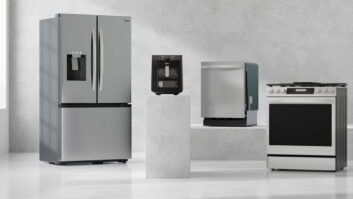
Independent retailers’ websites are often overlooked as a viable distribution channel. What they may lack in reach, they often make up with individualization and unparalleled customer service. In order to best capitalize on these opportunities, however, there are a few things manufacturers should keep in mind.
TWICE senior editor Alan Wolf explored these possibilities and solutions in the “Found Money” webinar, held earlier this month with Warren Chaiken, president/CEO, Almo; Jeff Knock, chief commercial officer, Nationwide Marketing Group; Peter Weedfald, sales and marketing senior VP, Sharp Electronics Marketing Co. of America; Karen Pike, global e-commerce product manager, Brand View; and Todd Scott, marketing director, Sealed Air Corp.
Click here to listen to a complimentary replay.
Wolf noted that consumer electronics and major appliance independent retailers operate thousands of storefronts across the country, and represent a combined sell-through rivaling that of Best Buy.
“What’s more,” he added, “independents employ tens of thousands of the best sales people in the business, who outperform the industry when it comes to selling higher-margin step-up products.”
Unfortunately, independents are often saddled with the reputation of being difficult and inefficient to work with collectively (Wolf said it’s been described as “herding cats”). A few simple tips, however, can make things run more smoothly and profitably for all partners.
One of the most important things manufacturers can do is to ensure they are providing ample product information to retailers. While some vendors have “horded” certain details for their own company websites, doing so only harms both parties as consumers now expect a plethora of information. This includes videos, which Scott said increases the chance of a sale by 64 percent.
For brick-and-mortar consumers, retailers would be wise to remember they are coming in further down the purchase model, Scott said. While this can be initially disheartening to floor salespeople, retailers with robust sites stand a better chance of closing the sale.
One minor detail that Scott said is desired by more than 70 percent of consumers: the ability to click to call or click for directions from the site, whether they are using an app or a browser. Even more important: 76 percent of people who conduct a local search on their smartphone visit a business within 24 hours, and 28 percent of those searches result in a purchase.
Millennials in particular prefer shopping locally, said Scott, and manufacturers ignoring the independent retailers do so at their own peril. A recent study showed that 40 percent of millennial participants prefer to shop locally, even knowing that they’ll have to pay a little more for their goods.
Nationwide’s Knock said total share of CE retail volume claimed by the independent channel is around 12.5 percent, while indie majap dealers lay claim to an even more impressive 28 percent of the market.
Independent dealers also have a stiffer grip on customer service. Chaiken said the dealers have a broader breadth of product offering, “especially if you’re talking about major appliances.” While big-box retailers may sell appliances, “that’s not where the end user wants to buy it.”
Sharp’s Weedfald took umbrage with the “herding cats” analogy, saying that manufacturers just need to work with the right partners. “We do a lot of homework. We actually categorize by geographic and size of locations,” he noted, adding that Sharp refuses to have the company sell against independent retailers.
The retailers, meanwhile, are acclimating to the new, digital world in which consumers are living. “Rather than herd cats, what we’re trying to do is back in to the model of the retailer and help them break through digital based on their model,” said Knock. “This is a very comprehensive, complex world we live in and it starts with many different kinds of media and multimedia channels. When you dig into to the different generations, it even becomes more complex. We’re moving in the direction. If we’re going to pick up market share, the first thing we’ve got to accomplish is create awareness of the marketplace, and we can’t do that like we have in the past.”
Some tips for manufacturers and sellers to consider:
Manufacturers should also consider working with content syndicators to allow their product details and relevant content be distributed widely across many smaller retailers.
Sharing can also be as simple as uploading content to an FTP site or other type of shared-folder location, allowing retailers to easily access the details. Data feeds are another alternative.
Product-comparison tools are important. Electronics shoppers prefer to stay on one site to compare, said Brand View’s Pike.
Continue to supply product details beyond the initial announcement. Independent retailers are often more nimble about updating their websites than big-box retailers, which can make all the difference in a sale. Likewise, independent retailers are often better at understanding the true cost of a product— especially for major appliances — because they are local and know what installation will cost, said Chaiken.
Paying for search-engine placement can also be extremely advantageous for independent retailers, according to Scott, and many smaller retailers are also heavily focusing on the benefits of organic search. “If I had a hundred bucks to spend, I would put it in search and optimize my search,” said Scott.












